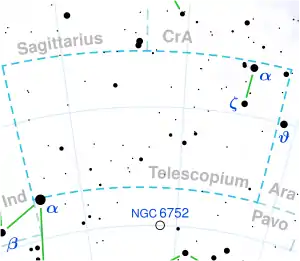 | |
| Observation data Epoch J2000.0 Equinox J2000.0 (ICRS) | |
|---|---|
| Constellation | Telescopium |
| Right ascension | 18h 53m 12.00295s[1] |
| Declination | −51° 55′ 53.1748″[1] |
| Apparent magnitude (V) | 6.29±0.01[2] |
| Characteristics | |
| Spectral type | B3/5 III[3] |
| B−V color index | −0.09[4] |
| Astrometry | |
| Radial velocity (Rv) | −23.0±4.3[5] km/s |
| Proper motion (μ) | RA: +2.869 mas/yr[1] Dec.: −12.640 mas/yr[1] |
| Parallax (π) | 2.8731 ± 0.0531 mas[1] |
| Distance | 1,140 ± 20 ly (348 ± 6 pc) |
| Absolute magnitude (MV) | −1.80[6] |
| Details | |
| Mass | 4.05[7] M☉ |
| Radius | 5.72±0.29[8] R☉ |
| Luminosity | 696[9] L☉ |
| Surface gravity (log g) | 3.56[7] cgs |
| Temperature | 14,824[10] K |
| Metallicity [Fe/H] | −0.01[7] dex |
| Age | 76[11] Myr |
| Other designations | |
| Database references | |
| SIMBAD | data |
HD 174430, also designated as HR 7093 or rarely 32 G. Telescopii, is a solitary blue-hued star located in the southern constellation Telescopium near Kappa Telescopii. It has an apparent magnitude of 6.29,[2] placing it near the limit for naked eye, even under ideal conditions. The object is located relatively far at a distance of 1,140 light-years based on Gaia DR3 parallax measurements,[1] but it is drifitng closer with a heliocentric radial velocity of −23 km/s.[5] At its current distance, HD 174430's brightness is diminished by 0.32 magnitudes due to interstellar extinction[14] and it has an absolute magnitude of −1.80.[6]
HD 174430 has a stellar classification of B3/5 III,[3] indicating that it is an evolved B-type star with the characteristics of a B3 and B5 giant star. It has also been given a less evolved class of B6 V.[15] It has 4.05 times the mass of the Sun[7] and 5.72 times the radius of the Sun.[8] It radiates 696 times the luminosity of the Sun[9] from its photosphere at an effective temperature of 14,824 K.[10] HD 174430 has a near solar metallicity of [Fe/H] = −0.01[7] and it is estimated to be 76 million years old.[11]
References
- 1 2 3 4 5 6 Vallenari, A.; et al. (Gaia collaboration) (2023). "Gaia Data Release 3. Summary of the content and survey properties". Astronomy and Astrophysics. 674: A1. arXiv:2208.00211. Bibcode:2023A&A...674A...1G. doi:10.1051/0004-6361/202243940. S2CID 244398875. Gaia DR3 record for this source at VizieR.
- 1 2 Høg, E.; Fabricius, C.; Makarov, V. V.; Urban, S.; Corbin, T.; Wycoff, G.; Bastian, U.; Schwekendiek, P.; Wicenec, A. (March 2000). "The Tycho-2 catalogue of the 2.5 million brightest stars". Astronomy and Astrophysics. 355: L27–L30. Bibcode:2000A&A...355L..27H. ISSN 0004-6361. S2CID 17128864.
- 1 2 Houk, Nancy (1978). Michigan catalogue of two-dimensional spectral types for the HD stars: Declinations −53° to −40°. Vol. 2. Bibcode:1978mcts.book.....H.
- ↑ Corben, P. M. (April 1971). "Photoelectric Magnitudes and Colours for Bright Southern Stars". Monthly Notes of the Astronomical Society of South Africa. 30 (4): 37. Bibcode:1971MNSSA..30...37C. ISSN 0024-8266.
- 1 2 Gontcharov, G. A. (November 2006). "Pulkovo Compilation of Radial Velocities for 35,495 Hipparcos stars in a common system". Astronomy Letters. 32 (11): 759–771. arXiv:1606.08053. Bibcode:2006AstL...32..759G. doi:10.1134/S1063773706110065. eISSN 1562-6873. ISSN 1063-7737. S2CID 119231169.
- 1 2 Anderson, E.; Francis, Ch. (May 2012). "XHIP: An extended hipparcos compilation". Astronomy Letters. 38 (5): 331–346. arXiv:1108.4971. Bibcode:2012AstL...38..331A. doi:10.1134/S1063773712050015. eISSN 1562-6873. ISSN 1063-7737. S2CID 119257644.
- 1 2 3 4 5 Anders, F.; et al. (February 2022). "Photo-astrometric distances, extinctions, and astrophysical parameters for Gaia EDR3 stars brighter than G = 18.5". Astronomy & Astrophysics. 658: A91. arXiv:2111.01860. Bibcode:2022A&A...658A..91A. doi:10.1051/0004-6361/202142369. eISSN 1432-0746. ISSN 0004-6361.
- 1 2 Kervella, P.; Thévenin, F.; Di Folco, E.; Ségransan, D. (October 2004). "The angular sizes of dwarf stars and subgiants". Astronomy & Astrophysics. 426 (1): 297–307. arXiv:astro-ph/0404180. Bibcode:2004A&A...426..297K. doi:10.1051/0004-6361:20035930. eISSN 1432-0746. ISSN 0004-6361.
- 1 2 McDonald, I.; Zijlstra, A. A.; Boyer, M. L. (21 November 2012). "Fundamental parameters and infrared excesses of Hipparcos stars: Parameters and IR excesses from Hipparcos". Monthly Notices of the Royal Astronomical Society. 427 (1): 343–357. arXiv:1208.2037. Bibcode:2012MNRAS.427..343M. doi:10.1111/j.1365-2966.2012.21873.x. eISSN 1365-2966. ISSN 0035-8711. S2CID 118665352.
- 1 2 Philip, A. G. D.; Egret, D. (May 1980). "An analysis of the Hauck-Mermillod catalogue of homogeneous four-color data. II". Astronomy and Astrophysics Supplement Series. 40: 199–205. Bibcode:1980A&AS...40..199P. ISSN 0365-0138.
- 1 2 Westin, T. N. G. (April 1985). "The local system of early type stars. Spatial extent and kinematics". Astronomy and Astrophysics Supplement Series. 60: 99–134. Bibcode:1985A&AS...60...99W. ISSN 0365-0138. S2CID 119020376.
- ↑ Gould, Benjamin Apthorp (1878). "Uranometria Argentina : brillantez y posicion de las estrellas fijas, hasta la septima magnitud, comprendidas dentro de cien grados del polo austral : con atlas". Resultados del Observatorio Nacional Argentino. 1. Bibcode:1879RNAO....1.....G.
- ↑ "HD 177430". SIMBAD. Centre de données astronomiques de Strasbourg. Retrieved August 5, 2023.
- ↑ Guarinos, J. (February 1995). "VizieR Online Data Catalog: Interstellar matter in the Galactic Disk (Guarinos J., 1992)". VizieR Online Data Catalog: 301V/86. Bibcode:1995yCat.5086....0G.
- ↑ Cucchiaro, A.; Macau-Hercot, D.; Jaschek, M.; Jaschek, C. (October 1977). "Spectral classification from the ultraviolet line features of S2/68 spectra. II. Late B-type stars". Astronomy and Astrophysics Supplement Series. 30: 71–79. Bibcode:1977A&AS...30...71C. ISSN 0365-0138.